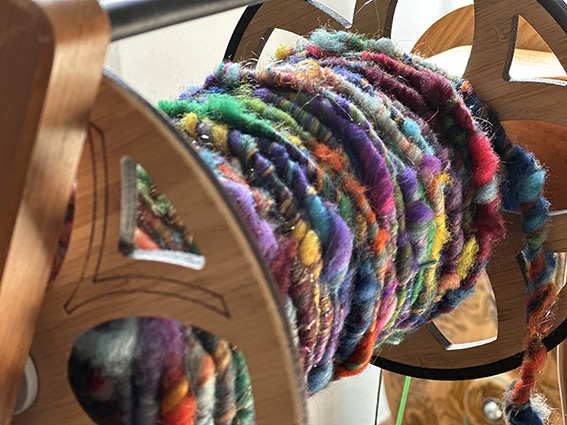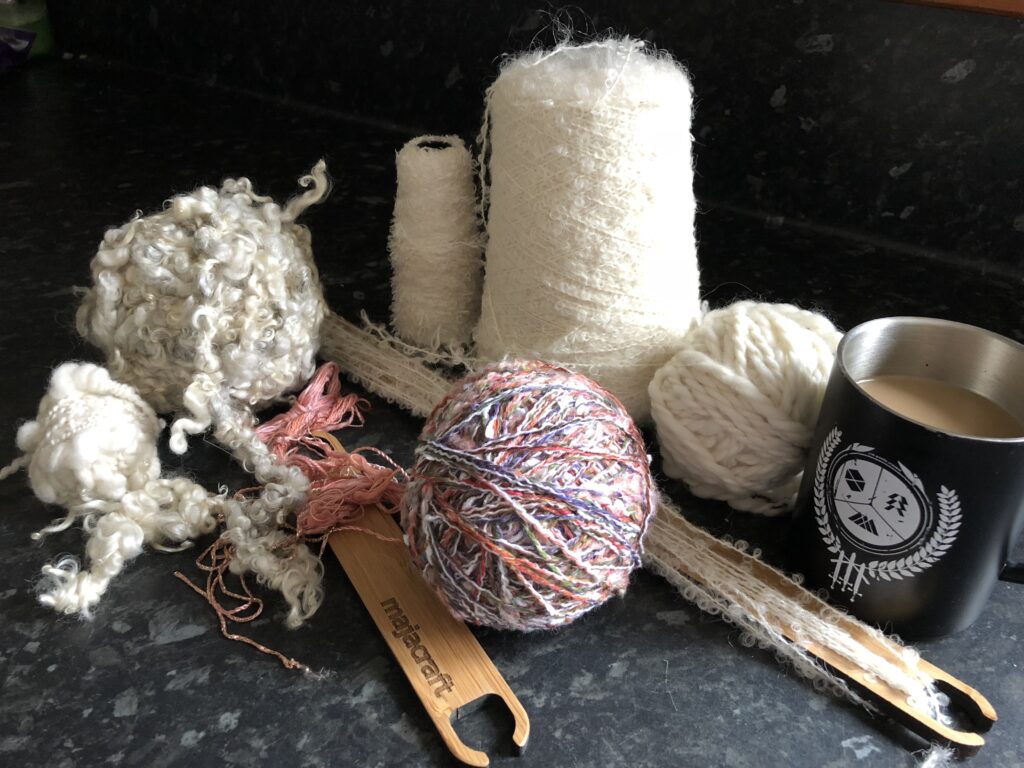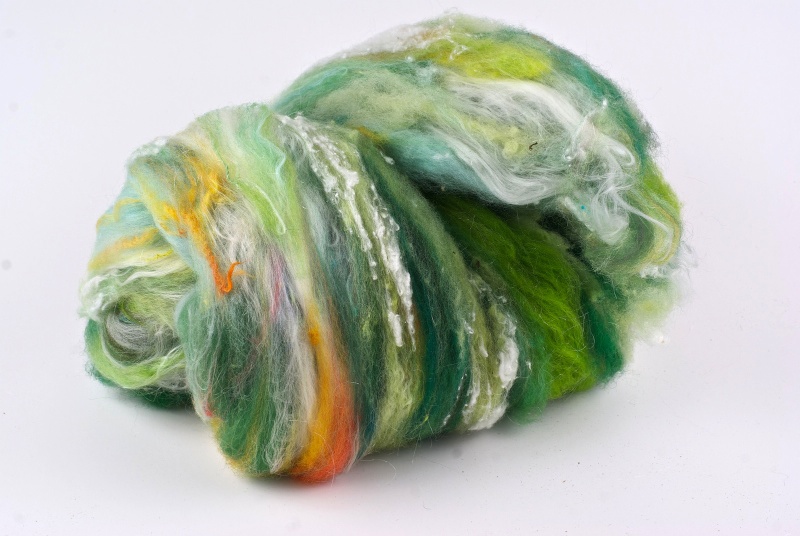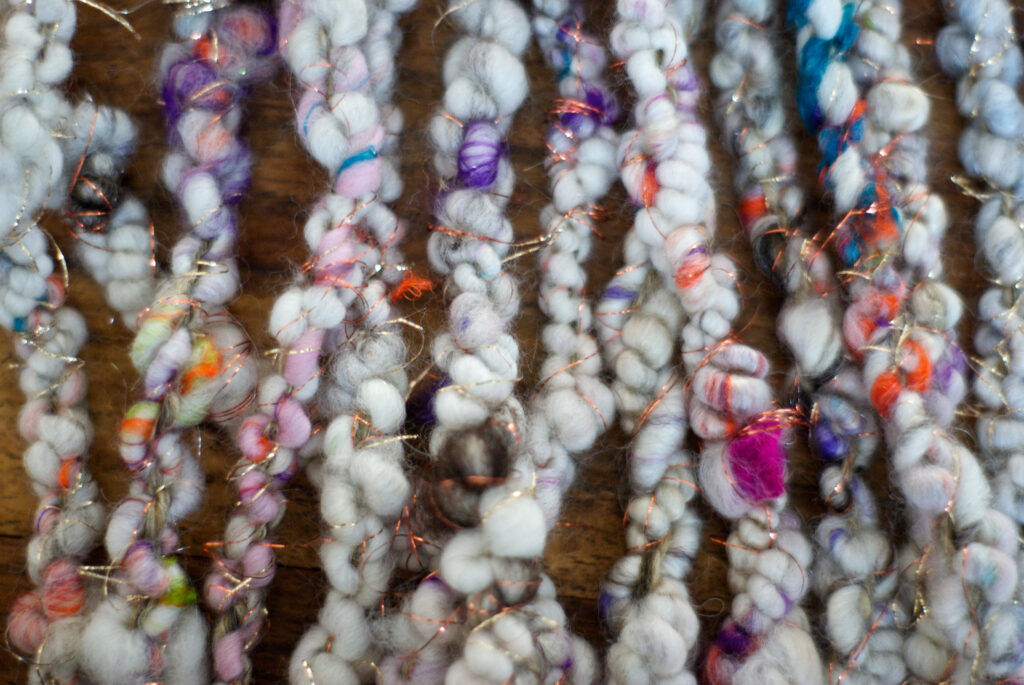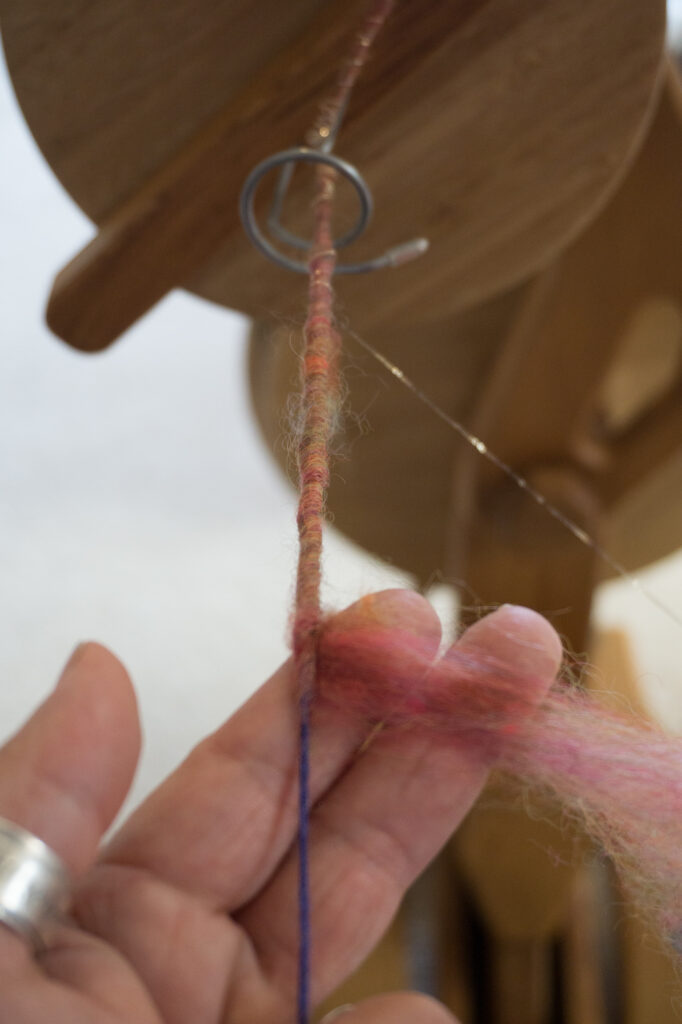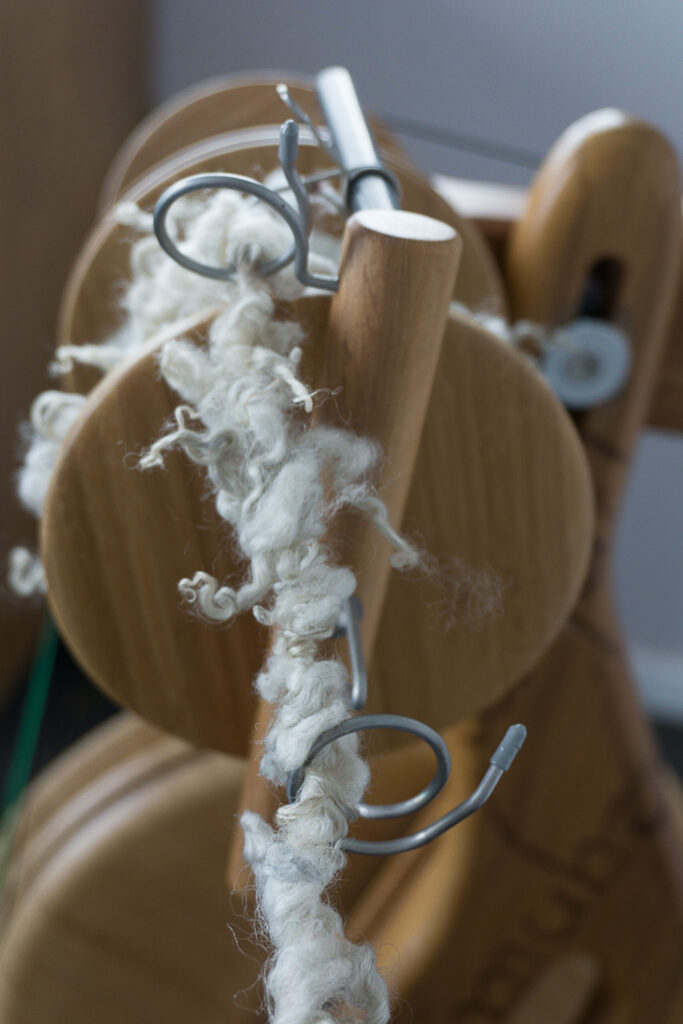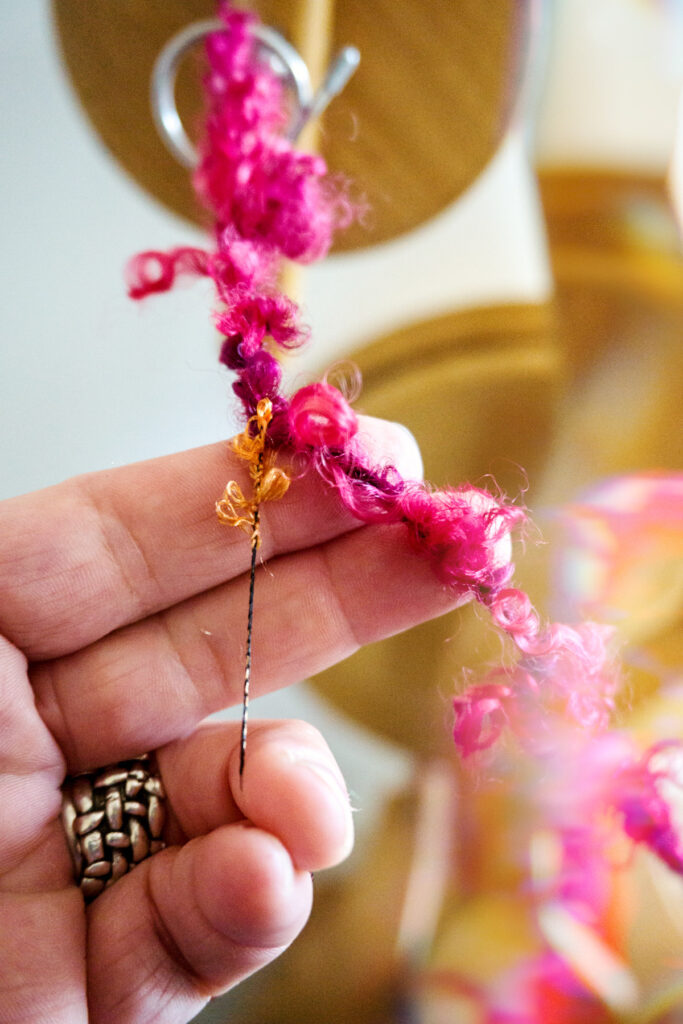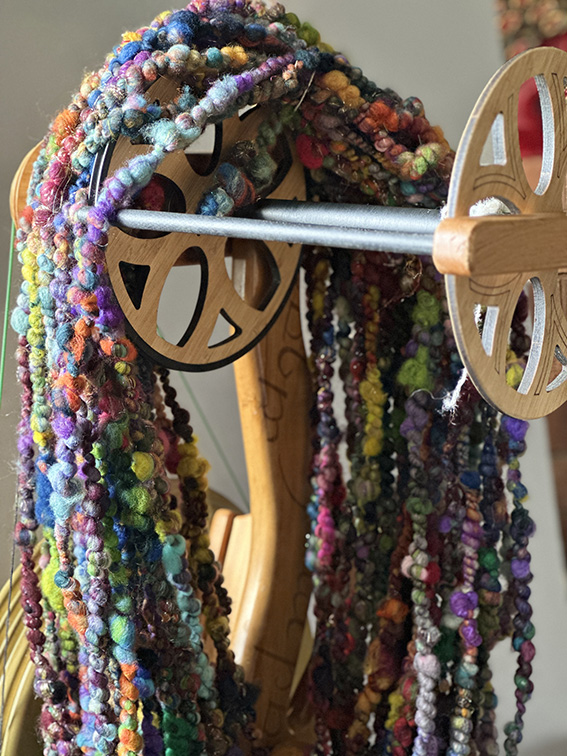Suzy Brown (WoolWench) for tinyStudio Magazine
This year I have chosen to focus on art yarns! While still filling tinyStudio magazine with a wonderful range of fiber arts, am I certainly also paying additional attention to the spinning of art yarns and the uses fiber artists are making of these wonderfully expressive yarns. As a long-time spinner of artistic and textured yarns (check out my Gallery of works here) this is a subject very close to my heart. I love how infinite the experimentations seem to be, how variations can be discovered and created by taking traditional techniques and varying fiber types, singles thicknesses, varying textures and colours, and my favourite; layering techniques to construct something new and exciting! Alongside my role as Editor/Publisher of tinyStudio magazine, I also wrote and teach the ‘Designer Yarns Certificate’ course for the New Zealand Spinners and Weavers Guild; Creative Fibre. Prior to this I co-authored the ‘Journey to the Golden Fleece’ course, a ten month creativity booster for spinners, and I have travelled around the world to teach art yarn workshops in Europe, the USA, Australia, and New Zealand. In all the classes I teach, my goal is to encourage experimentation and push the boundaries of your spinning comfort zone. See how many variations you can make with one technique!
If you are new to spinning ‘art’ or ‘expressive’ yarns, core spinning is one technique that I strongly suggest you learn and practice (it really only takes practice to get this ‘right’). You can adapt this technique to fit your theme by choosing fibres and colours that will work with your design. Alongside this mini tutorial, I also have a collection of videos available that will help you visualise the process and see the wide range of yarns that can be made with this technique.
You can access the video playlist from this link: https://youtube.com/playlistlist=PLDicbLKk0wmGw9bVlMUPcTxmkTLgGfABc I suggest starting with the video on how to select a good core thread.
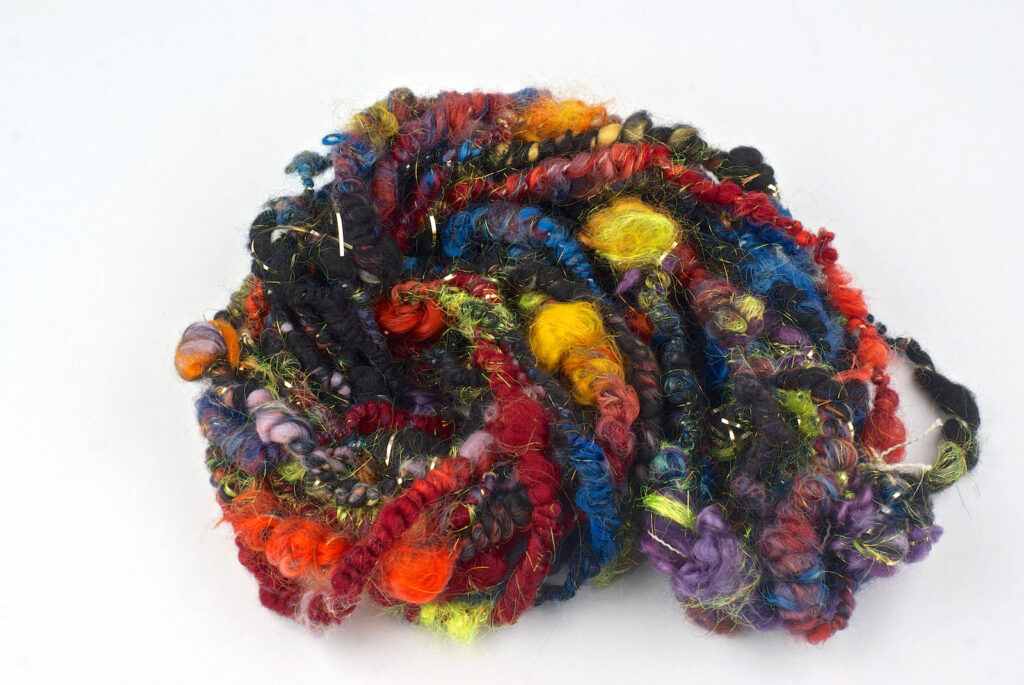
Core spinning is one of the most useful constructions when spinning art yarn for the following reasons:
- It provides stability and strength to fibres that would otherwise lack that stability, such as short locks spun for texture.
- It is a great way to use multi-coloured fibres to really show them all rather than lose them inside the yarn
- If you have a limited quantity of fibre, it uses less fibre to get more yardage.
- You can vary the texture and spin it smooth or ‘lock spun’, flat or fluffy, or all of those things in one yarn!
- It adds another dimension to your project because your spun fibres wrap widthwise around the yarn rather than run lengthwise along it.
Keep in mind, when planning your projects, that the nature of a core-spun yarn is that it will not have a great deal of ‘memory’ or stretch in the length of it, this makes it ideal for weaving, and it is really useful for projects such as cowls, bags, cushions etc. I tend to use core-spun as highlights in larger projects or for smaller crocheted or woven cowls, scarves, and wall hangings! If you are planning on using your smooth core-spun for anything that will get a lot of wear, such as a jacket or a bag, if you do not ‘finish’ this yarn well with a slight ‘fulling’ then you may find it will pill easier than a traditionally spun yarn. This is easily fulled by giving the yarn a good soak and enough agitation to slightly felt the surface to give it better stability.
Corespinning basics
Core Thread
Choose a core thread that is strong. This will provide the strength in your yarn, if it snaps easily your yarn will also snap easily and the entire yarn will fall apart.
Choose a yarn that is not smooth or slippery, something that will grab onto your fibers easily will make your spinning more enjoyable!
Choose a yarn that is not too thick, thin yarns are much more forgiving of the extra twist they will gather as you spin them into the core.
Choose a yarn that has some elasticity in it, cotton crochet threads (for example) that do not have any stretch at all can be very unforgiving of the extra twist you are going to add to it, and your yarn can end up feeling hard and over twisted.
I usually recommend a commercial mohair for this purpose, this can often be found quite cheap on cones and will fulfil all my requirements for core threads!
If you can’t find this then look for any commercial spun yarn that is plied and not overly thick. I usually try to find cheap core yarns which can often be found in thrift stores! Essentially anything can be used for core thread but when you are learning you need to give yourself every chance of success, some yarns can be very difficult and leave you in a tangled mess of over-twisted knots!
Fiber Choice
What you choose to spin around your core can vary and depends entirely on your yarn design and the kind of yarn you want to make. You could choose intact locks for great texture (and this is a good place to start for your first core-spun as it lends itself well to this technique). You could choose picked ‘fluffy’ locks for a loose textured look. You could choose commercial top for a smoothed look, or you could choose carded roving or a batt for a light, airy look.
For your first core spin I suggest either intact locks for a very textured effect, or a carded prep, which is open and easy to draft compared to top. Ease of drafting is important because you need to start by just getting comfortable with the technique without worrying about also having to draft fibres that want to fight you!
If you need a smooth yarn for your theme design, I suggest at least pre-drafting the commercial top to make it easier to manage, or why not use a hackle or combs to create your own combed prep that drafts like butter!
Plying choices
I am adding this information now, rather than after you have already made your single core-spun, because plying needs to be considered before you start spinning, so you know how much twist you will need and when to add it.
I almost always ply my core-spun yarns simply because I like balanced yarns. By its very nature, any single will not be balanced because all the twist in the single is going in one direction. This holds very true also for core-spun singles. You will always gain twist as you spin, and your single will always have twist in one direction. As you are learning to core spin, you may find that you have far too much twist, and your yarn is very kinked and curly. This is because you are taking an already balanced yarn (your core) and adding twist to it by holding it back from getting on the bobbin long enough to wrap all the fibre around it horizontally. Because it can take some time to get those fibres wrapped, the length of time you are holding it back creates a greater opportunity for that twist to build up, often actually travelling back down your core yarn to your supply, causing all kinds of undesirable things to happen…
The GOOD news is that, IF this happens, it will only happen as you are learning! This is one of those techniques where the only real ‘trick’ is to keep practising! As your hands and feet learn this new yarn, they will continue to work in a faster and more coordinated way, and after a while, you will definitely notice a reduction in the amount of extra twist you are getting in your core thread. Stick with it; you WILL get it!
And the last thing to remember – the spin police will not come and inspect your yarn; you can break your core thread at any time, remove the extra twist, knot it back together and keep core spinning over it. Unless you are spinning very fine, that knot will become invisible inside the yarn, and you can continue without needing to do battle with the kinks!
Spinning
Attach your leader as usual, and then attach your core thread to the leader; a knot will be fine.
Hold your core thread so it runs across your palm and through your hand, do not wrap it around your hand or your fingers, as that will cause you to hold on to it for too long and too much twist will build up.
The goal is to get the tension set up on your wheel as well as you can to start with, so it will gently draw the core thread from your hand and onto the bobbin, allowing you the time you need to draft your fibre and let it wrap while not dawdling so much that it will kink up. It is worth spending some time treadling and adjusting your wheel (let the core thread run onto the bobbin as you do this) to get it set up the best you can for this kind of spinning. You should always have enough tension and take-up to allow the yarn onto the bobbin without over-twisting and kinking up; you should always have continuous take-up and consistent tension on the core yarn.
As a general rule, for most wheels, you should expect to be using the middle-sized or largest whorl for a medium amount of twist. If you don’t get enough twist, your fibre won’t wrap well enough around the core and will stay loose. You should also expect to have much more tension than you do for a normal single, as you need your take-up to be stronger than usual.
Once you have your wheel set up:
Start treadling to build up some twist into the leader and into the start of your core thread. You will know when you have enough twist because if you hold the tips of your fibre supply touching the core thread, you will see it start to grab onto the core as the twist begins to catch it.
Keeping your fibre supply at a right angle to your core thread, let the fibre wrap around it. If you are spinning to create a fluffy textured yarn, you can just let it make its own way around the core thread, if you are spinning to create a smooth yarn, you can take your forefinger of the hand holding the thread and press it up against the fibre as it wraps around to smooth it against the core.
So you should have your first fibre around the core, don’t get too excited. Treadle slowly!!
Now it is time to draft out some more fibre, and you will be very pleased you have this loose, easy-to-draft supply! You need to reach around the core thread with the forefinger and thumb of the hand holding the thread (you are still guiding it across your palm). Keeping your fibre supply still at a right angle to the core thread, pinch the fibre with your thumb and forefinger of your thread-holding hand and draft it back with your fibre supply hand, and you have your next staple ready to wrap around the core.
Do not draft this fibre far enough to separate it from the supply but stop drafting when it starts to thin. Remember that you only need a little fibre to cover your core, but you need enough to make a solid layer around the core.
Judging just how much you will need to draft out for the kind of yarn you want to make it a matter of experience, so while you are learning, practice drafting varying amounts at a time and observe the effect this creates in your spun single.
Keep treadling and guide the fibre around the core thread, moving along the core thread as it feeds steadily into the bobbin. As you work, you will develop a ‘feel’ for how much to draft, when to move your hands, and how you prefer to have your wheel set up. Some people prefer more tension and a firmer grip on the core yarn. Others (like me) prefer to have an even steady pace and a light hold on the core thread, using your hand more as a guide than a restraint.
If you want to lock spin, then rather than drafting the fibres, you will want to open them only just enough to allow some to catch and hold the core. Remember, the more you draft, the smoother the yarn will become, so if you want a very ‘locky’ yarn with maximised texture, allow the fibres to take their own form and do not open them out before they wrap around the core.
Conversely, to make a smooth yarn, draft your fibres well, allowing them to stretch and smooth before you wrap them around the core.
Conversely, to make a smooth yarn, draft your fibres well, allowing them to stretch and smooth before you wrap them around the core.
Keep spinning your yarn until you have made as much as you want to!
When you let go of your core yarn, you will want to secure it so it cannot just unravel, this will cause your core-spun fibres to loosen around the core more than you would want. Be sure to fasten the end or keep the tension on it until you have finished. You can wind your yarn off onto a niddy noddy, keeping the tension on it, taking it straight from the niddy noddy to ‘finish’ by setting the twist – I do this by soaking it for a few minutes in hot water (this will relax the fibres) and then dropping it straight into cold water (this will tighten the fibres back up and help them hold onto each other). Hang to dry.
Don’t worry if there is twist in this skein; you can expect from a quarter twist in the skein to even a complete twist on a well-spun core-spun single. Keep this in mind when you are using it, that twist will remain energised and influence whatever you make with it, although in my opinion, anything a half turn or less in a finished skein will not make any difference in your project when using this generally heavier lock spun style of yarn.
I prefer to ply my core-spun yarns. I would normally do this with a thin plying thread, which must be strong, and as it will be visible, it should match up with your fibre colours in a way that pleases you.
Plying
A great technique for these yarns is a ‘spiral’ ply; this will serve to emphasise and ‘pop’ the texture you have created in your single, and it will add a pretty shell spiral design into your smooth spun singles, opening up the fibres and giving an airy look to your yarn.
Start by joining your thread and your single and attaching them to the leader.
Ply in the opposite direction from the one you spun your single with. It is very important to keep the tension on your ply thread, holding it straight towards you from the orifice, and your single should come from the side. When you have the correct angle for plying your core thread and your spun single will be somewhere between a 90 and a 45-degree angle, allowing the single to wrap around the thread in a gentle spiral shape.
If you do not have the correct angle for plying, you will either end up with a yarn that looks more like a traditional two-ply or a coiled yarn. You can vary the angle; however, to add different shapes and textures along your yarn, you should play with this a bit and see what you like! Just remember you will generally need to keep the plying thread with more tension on it than the single, which is allowed to roll around it.
PART TWO
Another variation we can consider is a smoother spun single using carded fibre to wrap around the core. This use of pre-prepared fibres means you will get a less textured single that will give you great options for plying to showcase different ply techniques. You can make these yarns as thick or thin as you like by varying the amount of fibre you draft around the core and by changing the number of ply steps you use.
One of the keys to making a smooth core-spun yarn is how you ‘press’ the fibre onto the core thread. You can use the index finger of the hand holding the core thread to smooth the fibre around the yarn as it wraps. This is easy to do by simply lifting that hand higher than the orifice to create an angle around your finger. This forces the fibre between your finger and the core, effectively pressing and shaping it around the core as it wraps.
Alternatively, if you want to create a fluffy, airy yarn, you can do this the opposite way by not touching the fibre at all once you have drafted it out and letting it make its own way around the core.
I suggest you practice both these techniques; you can even do this within one yarn to create some interesting variations in texture! It is a very good exercise for learning how to manipulate your fibres to create the differences you want. Remember, you are the boss! The fibre will do what you tell it to do, you just need to learn the ways you can control the way it wraps around the core, and conscious practice, doing and observing, is the best way to gain this control.
When it comes to plying, do not be afraid to increase the tension a lot more for plying than you had it for spinning the single, there is now more weight in the yarn, and the wheel has to work harder to draw it in. As your bobbin fills (unless you have a Majacraft Aura), you will likely need to continue increasing the tension as the bobbin gets heavier. You may find limitations in your wheel that you cannot overcome; for example, a traditional scotch tension wheel may not give you the take-up you need to get these large yarns onto the bobbin, and you may end up having to hand wind it on. The other limitation is your orifice and guide hook size. You will need to plan ahead to create multiple plied yarns, especially core-spun yarns that tend to be much thicker than a normal spun single. I would remind you here, however, that once your yarn will no longer fit through the orifice of your wheel and you want to ply it again, your trusty spindle will still work well for this! There are quite a few larger-sized spindles on the market that will be cheaper than buying another wheel just for the occasional art yarn spinning you might want to do, and a spindle has no orifice limitations. You will be amazed at what you can ply!
I hope you have enjoyed experimenting with core spinning! Remember that once you have mastered this technique, you will be able to increase your range of textured and expressive yarns substantially! This can form the basis for a very wide range of yarns, and it gives you more freedom to express yourself with fibre, keep practicing and observing your results, learn your wheel and your fibres and find the core threads that work for you, and most of all, have fun with your spinning!
